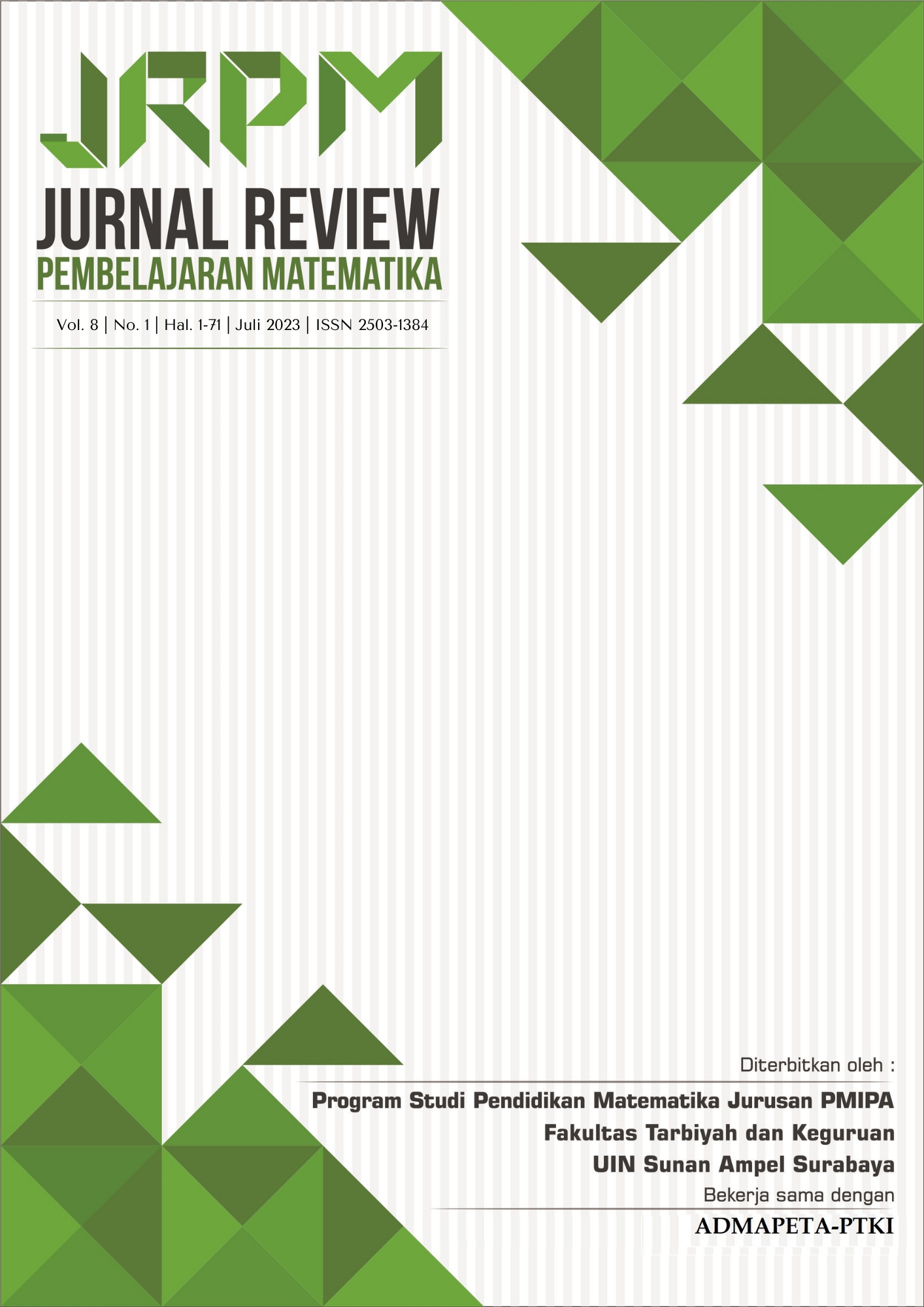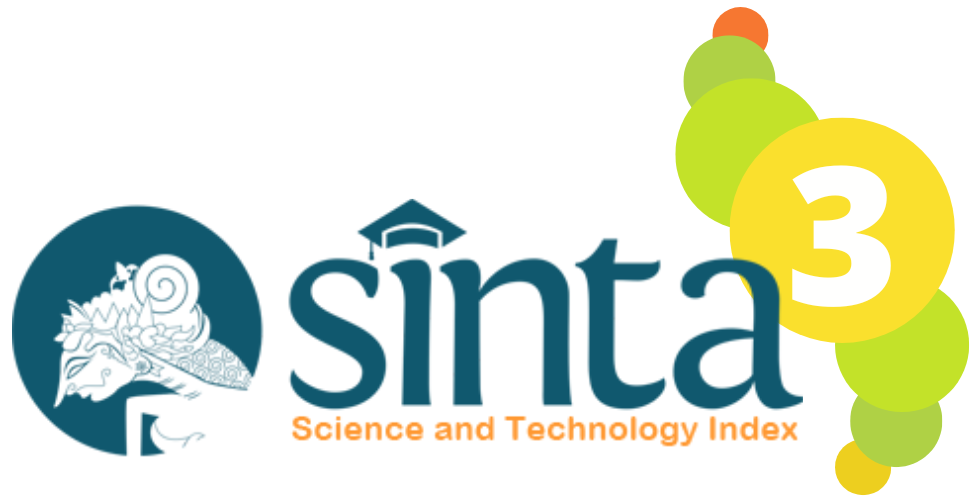Persepsi Guru Matematika terhadap Literasi Numerasi dan Pengaruhnya pada Pembelajaran di SMA
DOI:
https://doi.org/10.15642/jrpm.2023.8.1.50-62Keywords:
Teacher perception, Literacy numeracy, LearningAbstract
This study aims to determine the mathematics teacher's perception and its effect on literacy numeracy in high school. This research is descriptive qualitative. The population in this study were high school mathematics teachers. The sampling technique used is total sampling. A total of 30 teachers were sample correspondents spread across several high schools in Malang City. The data collection technique used was a questionnaire consisting of multiple choice, complex multiple-choice, and questions with yes or no answers, which aim to determine the mathematics teachers’ perception of literacy numeracy and its effect on learning in high school. Techniques for presenting data in descriptive statistics include tables and percentage calculations. The study’s results on the perception of mathematics teachers on literacy numeracy in high school showed an average of 67.58% with a positive interpretation level. Also, the effect of mathematics teachers' perceptions of literacy numeracy on learning in high school shows an overall average of 75.6% with a positive interpretation level.
Downloads
References
Adila Dwi Rizqi, P., Darmayanti, R., Sugianto, R., & Muhammad, I. (2023). Problem Solving Analysis Through Tests in View of Student Learning Achievement. Indonesian Journal of Learning and Educational Studies Indonesian Journal of Learning and Educational Studies, 1(1), 53–63. https://jurnal.piramidaakademi.com/index.php/ijles
Anisa, R. J., Jana, P., & Marsiyam, M. (2021). Persepsi Guru Matematika Terhadap Pembelajaran Dalam Jaringan (Daring). AKSIOMA: Jurnal Program Studi Pendidikan Matematika, 10(4), 2119. https://doi.org/10.24127/ajpm.v10i4.3707
Apriani, A., Ismarmiaty, I., Susilowati, D., Kartarina, K., & Suktiningsih, W. (2021). Penerapan Computational Thinking pada Pelajaran Matematika di Madratsah Ibtidaiyah Nurul Islam Sekarbela Mataram. ADMA: Jurnal Pengabdian dan Pemberdayaan Masyarakat, 1(2), 47–56. https://doi.org/10.30812/adma.v1i2.1017
Churchill, S. A., Inekwe, J., Ivanovski, K., & Smyth, R. (2018). The Environmental Kuznets Curve in the OECD: 1870–2014. Energy Economics, 75. https://doi.org/10.1016/j.eneco.2018.09.004
Crismasanti, Y. D., & Yunianta, T. N. H. (2017). Deskripsi Kemampuan Berpikir Kritis Siswa Kelas Vii Smp Dalam Menyelesaikan Masalah Matematika Melalui Tipe Soal Open-Ended Pada Materi Pecahan. Satya Widya, 33(1), 73. https://doi.org/10.24246/j.sw.2017.v33.i1.p73-83
Dallacqua, A. K. (2020). Reading Comics Collaboratively and Challenging Literacy Norms. Literacy Research and Instruction, 59(2), 169–190. https://doi.org/10.1080/19388071.2019.1669746
Dewabrata, M. (2019). Hasil PISA 2018 Resmi Diumumkan, Indonesia Alami Penurunan Skor di Setiap Bidang. Zenius.
Guyadeen, D., & Seasons, M. (2018). Evaluation Theory and Practice: Comparing Program Evaluation and Evaluation in Planning. In Journal of Planning Education and Research (Vol. 38, Issue 1). https://doi.org/10.1177/0739456X16675930
Hasanah, U., Edwita, & Januar, A. (2021a). Pendampingan Guru Mengembangkan Assesment Kompetensi Minimum (AKM) Berorientasi PISA untuk Meningkatkan Kualitas Hasil Pembelajaran di Sekolah Dasar Wilayah Kabupaten Bogor. JURNAL ABADIMAS ADI BUANA, 5(01), 90–99. https://doi.org/10.36456/abadimas.v5.i01.a3634
Herlanti, Y., Mardiati, Y., Rahmawati, R., Putri, A. M. K., Jamil, N., Miftahuzzakiyah, M., Sofyan, A., Zulfiani, Z., & Sugiarti, S. (2019). Finding Learning Strategy in Improving Science Literacy. Jurnal Penelitian Dan Pembelajaran IPA, 5(1). https://doi.org/10.30870/jppi.v5i1.4902
Hidayah, I. R., Kusmayadi, T. A., & Fitriana, L. (2021). Minimum Competency Assessment (Akm): An Effort to Photograph Numeracy. Journal of Mathematics and Mathematics Education, 11(1), 14. https://doi.org/10.20961/jmme.v11i1.52742
Humaidi, N., Darmayanti, R., & Sugianto, R. (2022). Challenges of Muhammadiyah’s Contribution in Handling Covid-19 in The MCCC Program in Indonesia. Khazanah Sosial, 4(1), 176–186. https://doi.org/10.15575/ks.v4i1.17201
Hung, J. C., & Wang, C. C. (2021). Exploring the website object layout of responsive web design: results of eye tracking evaluations. Journal of Supercomputing, 77(1). https://doi.org/10.1007/s11227-020-03283-1
Indefenso, E. E., & Yazon, A. D. (2020). Numeracy level, mathematics problem skills, and financial literacy. Universal Journal of Educational Research, 8(10). https://doi.org/10.13189/ujer.2020.081005
Junianto. (2019). Developing Students’ Mathematical Literacy through Problem Based Learning. Journal of Physics: Conference Series, 1320(1). https://doi.org/10.1088/1742-6596/1320/1/012035
Kamza, M., Husaini, & Ayu, I. L. (2021). Pembudayaan Literasi Numerasi untuk Asesmen Kompetensi Minimum dalam Kegiatan Kurikuler pada Sekolah Dasar Muhammadiyah. Jurnal Basicedu, 5(5), 4120–4126. https://doi.org/10.31004/basicedu.v5i5.1347
Kemendikbud, B. (2019). Pendidikan di Indonesia belajar dari hasil PISA 2018. Pusat Penilaian Pendidikan Balitbang KEMENDIKBUD, 021, 1–206. http://repositori.kemdikbud.go.id/id/eprint/16742
Lestari, N., & Putri, R. I. I. (2020). Using the Palembang’s Local Context in PISA-Like Mathematics Problem for Analyze Mathematics Literacy Ability of Students. Jurnal Pendidikan Matematika, 14(2), 169–182. https://doi.org/10.22342/jpm.14.2.6708.169-182
Muhammad, I., Marina Angraini, L., Darmayanti, R., & Sugianto, R. (2023). Students’ Interest in Learning Mathematics Using Augmented Reality: Rasch Model Analysis. Edutechnium Journal of Educational Technology, 1(1), 89–99. https://www.edutechnium.com/journal
Mustagfiroh, M. (2020). Memenfaatkan Hasil Asesmen Kompetensi Minimum (AKM) Untuk Mendesain Multimodal Learning. Jurnal Guru Inovatif, 2(1), 48–62.
Ningrum, R. C. (2021). PERSEPSI GURU SMK DI KOTA BANDUNG TERHADAP ASESMEN NASIONAL (AN) SEBAGAI ALAT EVALUASI SISTEM PENDIDIKAN. 4(1), 1–23.
Novita, N., Mellyzar, M., & Herizal, H. (2021). Asesmen Nasional (AN): Pengetahuan dan Persepsi Calon Guru. JISIP (Jurnal Ilmu Sosial Dan Pendidikan), 5(1). https://doi.org/10.36312/jisip.v5i1.1568
Nurhikmah, N., Hidayah, I., & Kadarwati, S. (2021). Persepsi dan Kesiapan Guru dalam Menghadapi Asesmen Kompetensi Minimum. Cokroaminoto Journal of Primary Education, 4(1), 78-83
OECD. (2010). PISA 2009 Results: Executive Summary. OECD Publishing. https://doi.org/10.1787/9789264091580-3-en
OECD. (2014). PISA 2012 Results in Focus (PARIS, Ed.). OECD Publishing.
OECD. (2016a). Result in Focus PISA 2015: Draft Science Framework. OECD Publishing.
OECD. (2016b). Results from PISA 2015: Indonesia. https://www.oecd.org/pisa/PISA-2015-Indonesia.pdf
OECD. (2019). Result in Focus PISA 2018: Draft Science Framework. In Oecd. OECD Publishing.
Oktaviyanthi, R., & Agus, R. N. (2019). Eksplorasi Kemampuan Pemecahan Masalah Berdasarkan Kategori Proses Literasi Matematis. Jurnal Pendidikan Matematika, 13(2), 163–184. https://doi.org/10.22342/jpm.13.2.7066.163-184
Perdana, N. S. (2021). Analysis of Student Readiness in Facing Minimum Competency Assesment. MUKADIMAH: Jurnal Pendidikan, Sejarah, Dan Ilmu-Ilmu Sosial, 5(1), 15–20.
Peraturan Menteri Pendidikan, Kebudayaan, Riset, dan Teknologi Nomor 17 Tahun 2021 tentang Asesmen Nasional.
Pratiwi, I. (2019). PISA Effect on Curriculum in Indonesia. Jurnal Pendidikan Dan Kebudayaan, 4(1), 51.
Purwanto, A. J. (2021). Pemahaman Siswa Kelas XI SMK Negeri 1 Pujer dalam Menyelesaikan Soal AKM Numerasi. Journal Of Mathematics Education and Learning, 1(2), 109-115. doi:10.19184/jomeal.v1i2.24272
Pusmenjar. (2020). AKM dan Implikasinya pada Pembelajaran. Pusat Asesmen Dan Pembelajaran Badan Penelitian Dan Pengembangan Dan Perbukuan Kementerian Pendidikan Dan KebudayaanPembelajaran Badan Penelitian Dan Pengembangan Dan Perbukuan Kementerian Pendidikan Dan Kebudayaan, 1–37.
Putra, Y. Y., Zulkardi, Z., & Hartono, Y. (2016). Pengembangan Soal Matematika Model PISA Level 4, 5, 6 Menggunakan Konteks Lampung. Kreano, Jurnal Matematika Kreatif-Inovatif, 7(1), 10–16. https://doi.org/10.15294/kreano.v7i1.4832
Qomariyah, S., & Darmayanti, R. (2023). Development of High School Students’ Mathematical Reasoning Ability Instruments on Three Dimension Material. Jurnal Edukasi Matematika dan Sains, 11(1), 249–260. https://doi.org/10.25273/jems.v11i1.14705
Qomariyah, S., Darmayanti, R., Rosyidah, U., & Ayuwanti, I. (2023). Indicators and Essay Problem Grids on Three-Dimensional Material: Development of Instruments for Measuring High School Students’ Mathematical Problem-Solving Ability. Jurnal Edukasi Matematika dan Sains, 11(1), 261–274. https://doi.org/10.25273/jems.v11i1.14708
Rahmah, K., Inganah, S., Darmayanti, R., Sugianto, R., & Ningsih, E. F. (2022). Analysis of Mathematics Problem Solving Ability of Junior High School Students Based on APOS Theory Viewed from the Type of Kolb Learning Style. IndoMath: Indonesia Mathematics Education, 5(2), 109–122. https://indomath.org/index.php/
Ratnasari, E. M. (2020). Outdoor Learning Terhadap Literasi Numerasi Anak Usia Dini. ThufuLA: Jurnal Inovasi Pendidikan Guru Raudhatul Athfal, 8(2). https://doi.org/10.21043/thufula.v8i2.8003
Rizki, N., Laila, A. R. N., Inganah, S., & Darmayanti, R. (2022). Analysis of Mathematic Connection Ability in Mathematics Problem Solving Reviewed from Student’s Self-Confidence. Seminar Nasional Teknologi Pembelajaran, 2(1), 111–126. http://snastep.um.ac.id/pub/index.php/proceeding/indexKeahliandanPerformaPakardalamTeknologiPendidikanuntuk
Rohim, D. C., Rahmawati, S., & Ganestri, I. D. (2021). Konsep Asesmen Kompetensi Minimum Meningkatkan Kemampuan Literasi Numerasi Sekolah Dasar untuk Siswa. Jurnal Varidika, 33(1), 54–62. https://doi.org/10.23917/varidika.v33i1.14993
Saal, L. K., & Shaw, D. M. (2020). Facilitating Civic Learning Within Adult Literacy/Education Curricula. Journal of Adolescent and Adult Literacy, 64(2). https://doi.org/10.1002/jaal.1084
Sah, R. W. A., Laila, A. R. N., Setyawati, A., Darmayanti, R., & Nurmalitasari, D. (2023). Misconception Analysis of Minimum Competency Assessment (AKM) Numeration of High School Students from Field Dependent Cognitive Style. JEMS: Jurnal Edukasi Matematika Dan Sains, 11(1), 58–69. https://doi.org/10.25273/jems.v11i1.14112
Sari, D. R., Lukman, E. N., & Muharram, M. R. W. (2021). Analisis Kemampuan Siswa dalam Menyelesaikan Soal Geometri pada Asesmen Kompetensi Minimum-Numerasi Sekolah Dasar. Fondatia, 5(2), 153–162. https://doi.org/10.36088/fondatia.v5i2.1387
Sugianto, R. (2014). Pengembangan Media Pembelajaran Matematika Berbasis Media Film pada Materi Aritmatika Sosial Kelas VII-D SMP Ulul Albab Sidoarjo. Universitas Islam Negeri Sunan Ampel Surabaya.
Sugianto, R., Cholily, Y. M., Darmayanti, R., Rahmah, K., & Hasanah, N. (2022). Development of Rainbow Mathematics Card in TGT Learning Model for Increasing Mathematics Communication Ability. Kreano: Jurnal Matematika Kreatif-Inovatif, 13(2), 221–234. http://journal.unnes.ac.id/nju/index.php/kreano
Sugianto, R., Darmayanti, R., Aprilani, D., Amany, L., Rachmawati, L. N., Hasanah, S. N., & Aji, F. B. (2017). Experiment on Ability to Understand Three-Dimensional Material Concepts Related to Learning Styles Using the Geogebra-Supported STAD Learning Model Abstra ct. Al-Jabar: Jurnal Pendidikan Matematika, 8(2), 205–212.
Svedholm-Häkkinen, A. M., & Kiikeri, M. (2022). Cognitive miserliness in argument literacy? Effects of intuitive and analytic thinking on recognizing fallacies. Judgment and Decision Making, 17(2).
Tohir, M. (2019). Hasil PISA Indonesia Tahun 2018 Turun Dibanding Tahun 2015. Tersedia Online: https://matematohir.wordpress.com/2019/12/03/hasil-pisa-indonesia tahun-2018-turun-dibanding-tahun-2015/
Tugtekin, E. B. (2020). Understanding the relationship between new media literacy, communication skills, and democratic tendency: Model development and testing. New Media and Society, 22(10), 1922–1941. https://doi.org/10.1177/1461444819887705
Ulumudin, I. (2020). Evaluasi Kegiatan Pembelajaran yang Dilakukan oleh Guru Berdasarkan Hasil PISA 2018. Jurnal Penelitian Kebijakan Pendidikan, 13(1). https://doi.org/10.24832/jpkp.v13i1.346.
Downloads
Published
How to Cite
Issue
Section
License
Copyright (c) 2023 Rahmad Sugianto, Niswatun Hasanah, Mohammad Syaifuddin

This work is licensed under a Creative Commons Attribution-ShareAlike 4.0 International License.













